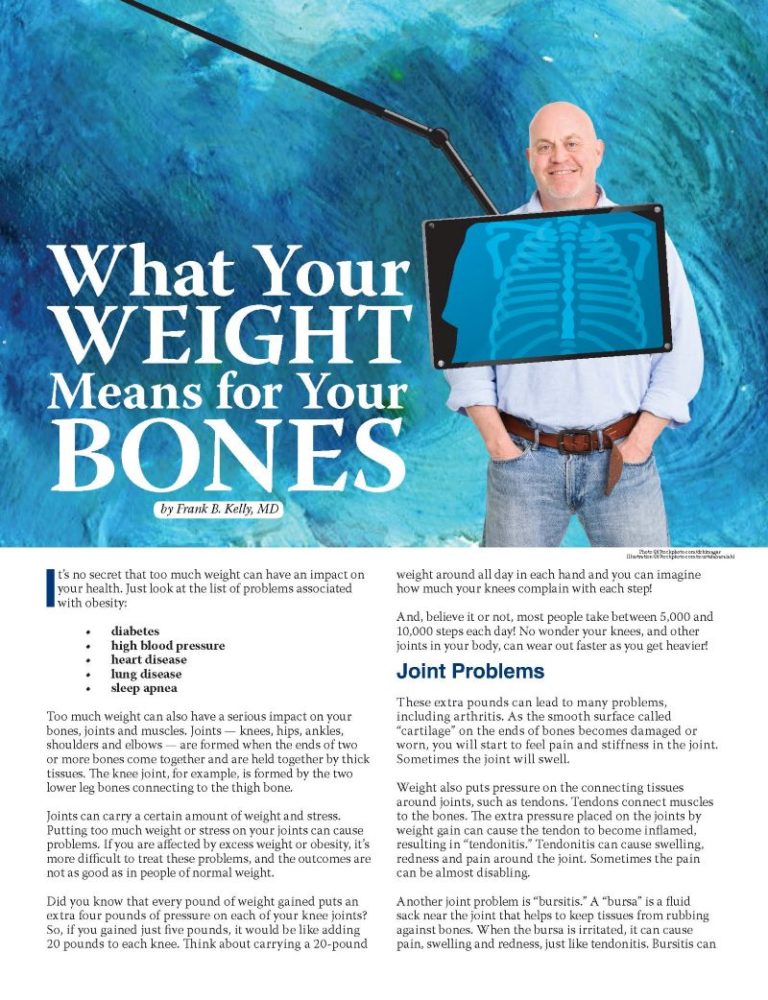What Your Weight Means for Your Bones


by Frank B. Kelly, MD
Fall 2013
It’s no secret that too much weight can have an impact on your health. Just look at the list of problems associated with obesity:
- diabetes
- high blood pressure
- heart disease
- lung disease
- sleep apnea
Too much weight can also have a serious impact on your bones, joints and muscles. Joints — knees, hips, ankles, shoulders and elbows — are formed when the ends of two or more bones come together and are held together by thick tissues. The knee joint, for example, is formed by the two lower leg bones connecting to the thigh bone.
Joints can carry a certain amount of weight and stress. Putting too much weight or stress on your joints can cause problems. If you are affected by excess weight or obesity, it’s more difficult to treat these problems, and the outcomes are not as good as in people of normal weight.
Did you know that every pound of weight gained puts an extra four pounds of pressure on each of your knee joints? So, if you gained just five pounds, it would be like adding 20 pounds to each knee. Think about carrying a 20-pound weight around all day in each hand and you can imagine how much your knees complain with each step!
And, believe it or not, most people take between 5,000 and 10,000 steps each day! No wonder your knees, and other joints in your body, can wear out faster as you get heavier!
Joint Problems
These extra pounds can lead to many problems, including arthritis. As the smooth surface called “cartilage” on the ends of bones becomes damaged or worn, you will start to feel pain and stiffness in the joint. Sometimes the joint will swell.
Weight also puts pressure on the connecting tissues around joints, such as tendons. Tendons connect muscles to the bones. The extra pressure placed on the joints by weight gain can cause the tendon to become inflamed, resulting in “tendonitis.” Tendonitis can cause swelling, redness and pain around the joint. Sometimes the pain can be almost disabling.
Another joint problem is “bursitis.” A “bursa” is a fluid sack near the joint that helps to keep tissues from rubbing against bones. When the bursa is irritated, it can cause pain, swelling and redness, just like tendonitis. Bursitis can develop after an injury or due to frequent repetitive motions (overuse), but it can also result from being affected by excess weight.
Treating some joint problems may be simple. Losing weight, applying ice to the sore joint, resting the joint, and taking aspirin or other over-the-counter medicines can help reduce the pain, swelling and redness.
Joint Replacement Surgery
But if the pain and damage to the joint become really bad, the only option may be to replace the painful joint. During joint replacement surgery, the bone is cut, shaped and replaced by an artificial joint, called “prosthesis.” The prosthesis is usually made of metal (such as steel or titanium) and plastic. Joint replacement surgery is very successful in relieving the pain due to arthritis. Many joints can be replaced. The most common types of joint replacement surgery involve the knee or the hip, but ankle, shoulder, and elbow joints can also be replaced.
The important thing to know is that the chances of needing joint replacement surgery and of having the surgery at a younger age are much greater in people who are affected by excess weight or obesity.
In fact, if you are affected by obesity, you are 20-times more likely to need a knee replacement than someone who is not affected by excess weight. And you will probably need this surgery seven or eight years earlier than someone of normal weight.
Joint replacement surgery, like every other surgery, has risks, which your surgeon will discuss with you. In addition, problems may occur afterward. These complications occur more often in patients who are affected by obesity, regardless of the type of surgery that takes place. Here are some of the most common complications after joint replacement surgery:
- Infection (germs causing pain, redness, and warmth in the joint) – If the infection is severe, the doctor may have to remove the artificial joint, wait until the infection heals and then insert a second prosthesis.
- Blood clots (a blockage of blood that can occur in the blood vessels of your legs after surgery) – This is a potentially deadly condition if the blood clot breaks free and moves up to the heart or the lungs.
- Dislocation of the replacement joint (especially in hip replacement) – This happens when the metal or ceramic hip ball slips out of the plastic socket.
Surgery in patients affected by obesity can have other problems. Excess fat makes it harder for the surgeon to find and reach the bone, so the surgery is more difficult. The surgery may take longer and the surgeon may have to make a longer or larger cut in the skin – resulting in a larger scar. After surgery, wound healing and physical therapy to return to previous levels of activity may take longer.
But there’s still good news! Despite these problems, patient who are affected by excess weight or obesity have outcomes — relief of pain and getting better use of the joints — that are just as good as those in patients of normal weight.
Other Issues to Consider
Did you know that people who weigh too much are more likely than normal-weight people to injure themselves? And patients affected by excess weight have more chances for problems, complications, while the
injury heals.
For example, dislocations of the knee joint (when the thigh bone becomes separated from the lower leg bones) are more common in people who are affected by excess weight. And even though you might think that weight would make bones stronger, fractures (broken bones) of the ankle, hip, thigh, and shin bones occur more frequently in people affected by excess weight.
But even if you have not had an injury and do not have arthritis, having too much weight can go hand-in-hand with pain in your bones and joints. This is especially true in older people, even if they are healthy in every other way.
Chronic Pain Syndrome
This kind of pain is called “long-term” pain or, in medical terms, “chronic pain syndrome.” As your weight increases, you are more likely to have chronic pain syndrome. Part of the problem can probably be explained by the increased strain that the extra weight puts on the joints.
Chronic pain, especially in the knees and feet, is more common in children who are affected by childhood obesity than in children of normal weight. In fact, people who are affected by excess weight or obesity are at least two-times more likely to have long-term pain than people of more normal weight.
For more information on musculoskeletal conditions and treatments, visit the patient education Web site of the American Academy of Orthopaedic Surgeons at www.orthoinfo.org.
Next Steps
Although extra weight can cause problems for your bones and joints, a good weight-loss program can help prevent many of these problems. If you are affected by excess weight, it is important for you to recognize and understand what that extra weight really means for your bones. It is also important that you be willing to deal with these problems by starting a good weight-loss program.
Losing weight can decrease your chances for developing a condition such as arthritis or chronic pain syndrome. It can also lessen your chances for an injury, such as a broken bone. Most doctors understand how hard it is to lose weight. But at the same time, they don’t want patients to face more risks during and after surgery. So your doctor may want to delay joint replacement surgery until you lose some weight.
Your doctor should be supportive, respectful, and compassionate. He or she can refer you to Web sites and programs that can help you lose weight.
Losing weight can mean a lot for your bones: less chance for broken bones, less chance for long-term pain, and better outcomes if surgery is needed. Bottom line: a better quality of life!
About the Author:
Frank B. Kelly, MD, is in the private practice of orthopaedic surgery and a partner at Forsyth Street Orthopaedic Surgery in Macon, Ga. He earned an AB degree in chemistry at the University of North Carolina at Chapel Hill and his MD degree at the Medical College of Georgia in Augusta, Ga. He completed his residency in orthopaedic surgery at the University of Tennessee/Campbell Clinic. Dr. Kelly served as co-chair of a forum on “Obesity, Orthopaedics, and Outcomes,” sponsored by AAOS Now and held at the annual meeting of the American Academy of Orthopaedic Surgeons in Chicago in March 2013.
by Kendall Griffey, OAC Communications Manager Spring 2024 We have officially kicked off Your Weight Matters Regional…
Read ArticleTelemedicine became a popular tool during the pandemic because it allows healthcare professionals to provide medical care…
View Videoby Kendall Griffey, OAC Staff; and Chrystal Jones, OAC Staff Fall 2022 For over ten years, the…
Read Article









